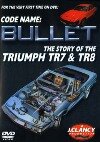Model Page
Triumph TR7 Sprint
|
Produced: |
1977 |
|---|---|
|
Production Run: |
60 (Estimate) |
|
Built: |
Speke (UK) 1977 |
|
Engine: |
Triumph Slant Four 1,998cc 16 valve |
|
0-60: |
8.5 secs (Estimate) |
|
Max Speed: |
120 mph (Estimate) |

The Triumph TR7 Sprint is a prototype vehicle developed by Triumph fitted with the potent 2.0 litre 16 valve engine as fitted to the Dolomite Sprint. Ever since the introduction of the original TR7 in 1974 speculation had been rife as to whether Triumph would answer calls for a high performance TR7 by shoehorning the 16 valve Dolomite engine into the new wedge shaped TR7.
Designed by a team headed by Lewis Dawtry and Harry Webster the base TR7 was powered by a 1,998cc evolution of Triumph new Slant Four engine that started life as 1,854cc in capacity, the eight valve four cylinder engine was fitted with twin SU HS6 Carburettors and generated 105 bhp @ 5,500 rpm and 119 lb/ft @ 3,500 rpm. The base model was capable of a 0-60 mph in around 10 seconds and a top speed nudging 110 mph – clearly lacking somewhat in the performance department for a vehicle adorned with the TR badge.
Unbeknownst to journalists Triumph were in fact already drawing up plans for high performance TR7, product designers anticipating a two pronged attack on the market on what would eventually become the TR7 Sprint and TR8. The two litre 8 valve TR7 would provide the backbone of the range, next was to be the TR7 Sprint essentially a TR7 equipped with a two litre 16 valve engine and at the top of the tree would be the TR8 powered by Rover’s 3.5 litre V8. The logic of introducing the TR7 Sprint and TR8 might seem a little flawed considering the relatively similar power outputs of 127 bhp and 135 bhp but in fact the company were simply addressing differing market needs. For European markets was the TR7 Sprint - generally car buyers in Europe were more discerning demanding high levels of sophistication whereas the primary market for the TR8 would be the US where buyers considered large, torquey V8 engines to be more the norm.
Installing the 16 valve engine from the Dolomite Sprint into the TR7 engine bay would be a relatively simple tasks after all the 8 valve engine currently in use was in the main the same engine - in fact all that was required was a revised exhaust manifold and a new air filter housing to suit the wider gap present between the inlets for the twin SU carburettors. The replacement exhaust manifold had a positive impact on performance, it restricting air flow less than that fitted to the Dolomite freeing some additional horsepower from the engine.
The Slant Four 16 valve engine developed 127 bhp @ 5,200 rpm and 122 lb/ft @ 4,500 rpm – a significant improvement over the 8 valve engine furthermore the 16 valve unit was a more freely revving engine and suited the car much more satisfactorily. Outputs on factory standard engines installed in the Dolomite Sprint varied quite widely with some engines developing as much as 135 bhp. Due to inconsistencies with manufacture Triumph specified the output as being 127 bhp, it can be considered that with the free flowing manifold in place the TR7 Sprint developed much closer to this top end figure.
Mechanically very little needed to be done to the original TR7 to adapt it for use with the Sprint 16 valve engine; the original manual gearbox and rear differential being deemed too fragile for the task were replaced with a five speed manual gearbox and rear axle both taken from its BL stable mate the Rover SD1. Braking was upgraded to match the higher performance potential; the vehicles were fitted with larger brakes than that installed in the standard TR7 with TR8 specification callipers, larger pads and discs unique to the Sprint that were thicker than the TR7 but narrower than the heavier TR8. The suspension and steering systems were considered more than adequate for the new application and were therefore left untouched.
All TR7 Sprints were manufactured with TR7 fixed head coupe body shells for the 1978 model TR7 or TR8 – no cabriolets were produced. Exterior changes were minimal; the Sprint was distinguished from the standard TR7 through the addition of TR7 Sprint badges on the nose cone and boot lid and a side stripe running along the side of the car similar to that found many years later on the TR7 Premium edition. Steel wheels with full plastic covers or GKN sourced Alloy wheels completed the packaging.
Product testing found that the TR7 Sprint could achieve a 0-60 Mph time of around 8.5 seconds and reach in excess of 120 mph, a significant improvement over the standard 8 valve powered models no doubt this could have been improved on further had more appropriate gearing been used.
Estimations on the number of pre production TR7 Sprints that were manufactured varies wildly from as little as 25 up to 60 vehicles, according to an article by Graham Fountain for the TR Driver Magazine two batches of vehicles were produced the first being 25 and the second a larger batch of 35 examples. A number of these vehicles were sent for stress and reliability testing whilst others were sent to the press office for publicity and marketing purposes.
Triumph had began preparations for introducing the model to the UK market for the 1978 model year but this was hampered by poor industrial relations resulting in huge disruption to production. In November of 1977 workers at Speke went on strike and in all essence did not return to work until October 1978 but for a brief respite whereby a limited production was resumed between April and May, shortly afterwards the facility was closed down and production transferred to Canley - it appears that at this time the TR7 Sprint project was shelved, the moment was lost. Other reports suggest that management had not wanted to tarnish the reputation of the TR7 by fitting the 16 valve engine that had proved relatively troublesome in the Dolomite Sprint mainly due to poor maintenance and lack of dealer training.
Trawling through classified will reveal a number of TR7 fitted with the 16 valve engine, most of these being modified TR7’s rather than genuine TR7 Springs. A TR7 Sprint chassis can be identified readily as each genuine chassis number starts with ACH, engine numbers should start with CH and have a HE suffix (Dolomite Sprint engines having a VA suffix).
Interestingly even though the car never entered full production a number of TR7 Sprints were homologated and subsequently entered into Rallying events and proved competitive on asphalt winning a number of events including the Belgian Boucles de Spa rally in 1977 before ultimately being replaced by the TR8.
Today genuine TR7 Sprints are highly sought after, due to the limited numbers of these vehicles they very rarely become available and as such values are considerably higher than that of the 8 valve TR7 and are somewhat higher than genuine TR8’s. Fortunately as the Sprint is so closely related to the standard 8 valve vehicle restoration of such cars is entirely possible as there are very few bespoke items and most parts are still readily available.
|
Engine: |
Triumph Slant 4 SOHC |
|---|---|
|
Capacity: |
1,998 cc |
|
Valves: |
16 |
|
Compression Ratio: |
9.5:1 |
|
Fuel System: |
Twin SU Carburettors |
|
Maximum Power: |
127 bhp @ 5,200 rpm |
|
Maximum Torque: |
122lb ft @ 4,500 rpm |
|
Transmission: |
Manual 5 Speed |
|
Top Gear: |
27.6 mph per 1000 rpm |
|
Brakes: |
Servo Assisted Vented front discs / rear drums |
|
Kerb Weight: |
1050 Kg (Estimate) |
|
0-60: |
8.5 Secs (Estimate) |
|
Max Speed: |
120 Mph (Estimate) |






